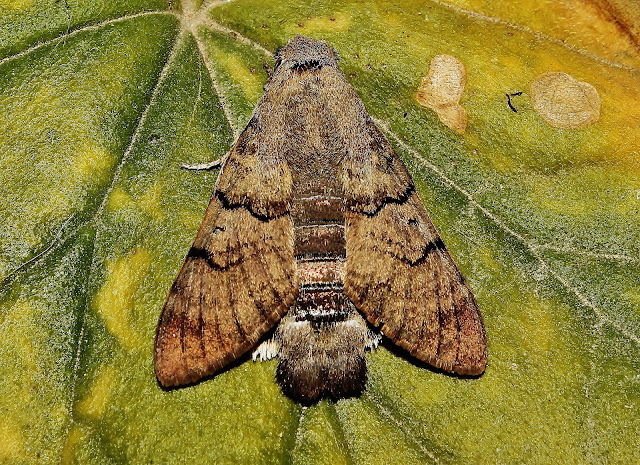See also - List of Moths of Cyprus you will find in this blog (Lepidoptera)
 The hummingbird hawk-moth (Macroglossum stellatarum) is a species of Sphingidae. Its long proboscis and its hovering behaviour, accompanied by an audible humming noise, make it look remarkably like a hummingbird while feeding on flowers. It should not be confused with the moths called hummingbird moths in North America, genus Hemaris, members of the same family and with similar appearance and behavior. The resemblance to hummingbirds is an example of convergent evolution. It flies during the day, especially in bright sunshine, but also at dusk, dawn, and even in the rain, which is unusual for even diurnal hawkmoths. Its visual abilities have been much studied, and it has been shown to have a relatively good ability to learn colours.
The hummingbird hawk-moth (Macroglossum stellatarum) is a species of Sphingidae. Its long proboscis and its hovering behaviour, accompanied by an audible humming noise, make it look remarkably like a hummingbird while feeding on flowers. It should not be confused with the moths called hummingbird moths in North America, genus Hemaris, members of the same family and with similar appearance and behavior. The resemblance to hummingbirds is an example of convergent evolution. It flies during the day, especially in bright sunshine, but also at dusk, dawn, and even in the rain, which is unusual for even diurnal hawkmoths. Its visual abilities have been much studied, and it has been shown to have a relatively good ability to learn colours. The hummingbird hawk-moth is distributed throughout the northern Old World from Portugal to Japan, but is resident only in warmer climates (southern Europe, North Africa, and points east). It is a strong flier, dispersing widely and can be found virtually anywhere in the hemisphere in the summer. However it rarely survives the winter in northern latitudes (e.g. north of the Alps in Europe, north of the Caucasus in Russia). They have been spotted in Newfoundland, Canada as well.
The hummingbird hawk-moth is distributed throughout the northern Old World from Portugal to Japan, but is resident only in warmer climates (southern Europe, North Africa, and points east). It is a strong flier, dispersing widely and can be found virtually anywhere in the hemisphere in the summer. However it rarely survives the winter in northern latitudes (e.g. north of the Alps in Europe, north of the Caucasus in Russia). They have been spotted in Newfoundland, Canada as well.
Moths in the Hemaris genus of the family Sphingidae are known as "hummingbird moths" in the US, and "bee moths" in Europe, which sometimes causes confusion between this species and the North American genus.
 Two or more broods are produced each year. The adult may be encountered at any time of the year, especially in the south of the range, where there may be three or four broods. It overwinters as an adult in a crevice among rocks, trees, and buildings. On very warm days it may emerge to feed in mid-winter
Two or more broods are produced each year. The adult may be encountered at any time of the year, especially in the south of the range, where there may be three or four broods. It overwinters as an adult in a crevice among rocks, trees, and buildings. On very warm days it may emerge to feed in mid-winter
The glossy pale green eggs are spherical with a 1-millimetre (0.039 in) diameter. They are said to look like the flower buds of the host plant Galium, and that is where the female lays them. They hatch 6 to 8 days after laying. Up to 200 eggs may be laid by one female, each on a separate plant.
Newly hatched larvae are clear yellow, and in the second instar assume their green coloration.
The larva is green with two grey stripes bordered in cream along the sides and the horn at the rear end typical of sphingids. The horn is purplish red, changing to blue with an orange tip in the last instar. They feed fully exposed on the top of the host plant and rest in among a tangle of stems. Although dependent on warmth and sun, the larval stage can be as rapid as 20 days.
The pupae are pale brownish with a prominent, keeled proboscis, and two sharp spines at the end of the cremaster. They are enclosed in loose silken cocoons among the host plant debris or on the ground among leaf litter
The forewings are brown, with black wavy lines across them, and the hindwings are orange with a black edge. The abdomen is quite broad, with a fan-tail of setae at the end. The wingspan is 40–45 millimetres (1.6–1.8 in).
In the southern parts of its range, the hummingbird hawk-moth is highly active even when temperatures are high, and thoracic temperatures above 45 °C (113 °F) have been measured. This is among the highest recorded for hawk-moths, and near the limit for insect muscle activity.
From Wikipedia, the free encyclopedia
Photos and video Nicosia by George Konstantinou

No comments:
Post a Comment